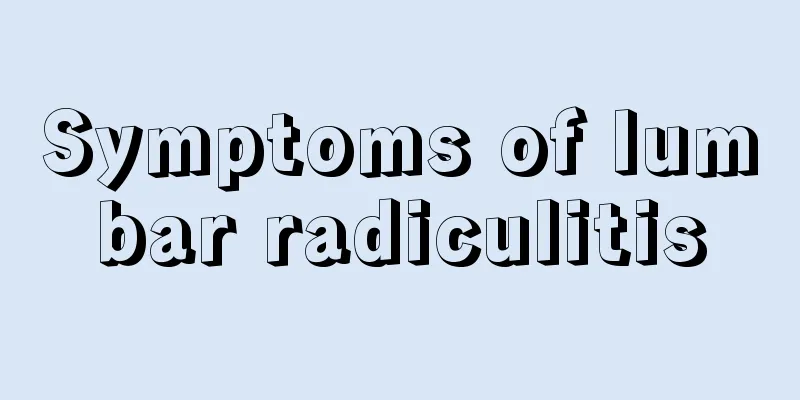Symptoms of lumbar radiculitis

|
Lumbar radiculitis is a relatively serious neurological disease, which mainly refers to the inflammation of the nerves in the lumbar sacral area due to bacterial infection, etc., which causes serious damage to the lumbar spine. Patients with lumbar radiculitis often feel discomfort in the lumbar spine. Sitting or standing for a long time will put a lot of pressure on the lumbar spine, so anti-inflammatory treatment is needed as soon as possible. So, what are the symptoms of lumbar radiculitis? Radiculitis is a general term for inflammatory or degenerative lesions of the spinal nerve roots caused by various reasons. The lesions can affect the spinal nerve roots of any segment of the cervical, thoracic, lumbar, and sacral segments. Clinically, the cervical and thoracic nerve roots and lumbar and sacral nerves are most commonly affected, which can cause shoulder and back pain and low back and leg pain. Causes There are many causes of radiculitis, and the causes of intradural and extradural radiculitis are also different. Intrathecal radiculitis is often caused by infection, poisoning, nutritional and metabolic disorders, etc.; extrathecal radiculitis is often caused by local cold, moisture, muscle and transverse process trauma and inflammation, etc. The lesions of intramembranous radiculitis are often extensive and bilateral; the lesions of extramembranous radiculitis are often more limited and unilateral. Clinical manifestations The onset of cervicothoracic radiculitis is more common in acute and subacute forms, and is often manifested by pain, numbness, and weakness in one or both sides of the shoulder and arm. The pain often radiates along the distal lateral or medial side of the upper limb and worsens with coughing, straining, and defecation. The above symptoms are often obvious after exposure to cold or fatigue, and are alleviated after warmth and rest. Examination may reveal hypersensitivity (early stage), reduction or disappearance (late stage) of sensation in the area innervated by the affected nerve roots; weakened or disappeared biceps and triceps tendon reflexes; mild atrophy of upper limb muscles; and tenderness near the corresponding cervical and thoracic vertebrae. In addition, there may be autonomic nervous system symptoms such as changes in skin temperature and color, nutritional and sweat gland secretion disorders. treat Eliminate the cause of the disease, improve neurotrophic metabolism and promote the recovery of nerve function. 1. Etiological treatment to control various infections and diabetes, etc. 2. For drug treatment, you can choose prednisone or dexamethasone, and use B vitamins, coenzyme Q10, citicoline and other drugs at the same time to promote nerve repair and functional improvement. You can also use dibazole, galantamine, potassium iodide, etc. to improve circulation and promote inflammation absorption. For those with obvious pain, you can use carbamazepine or phenytoin sodium for treatment. 3. Physical therapy, local hot compress and massage all have certain therapeutic effects. |
<<: Symptoms of measles, mumps and flu
>>: The benefits of green coconut juice
Recommend
Is anemia a complication of pancreatic cancer?
Pancreatic cancer troubles many patients, leaving...
Children need the company of their parents
Children are very sensitive when they are young, ...
Radiation therapy is a common treatment for advanced lymphoma
Lymphoma is a malignant tumor disease, but it is ...
What to do if you have dark circles under your eyes
What should you do if you have dark circles under...
What are the causes of vomiting in gallbladder cancer
Nearly half of patients with early-stage cardia c...
Tips for practicing Dantian for singing
Everyone likes to learn to sing, but they will fi...
What are the early symptoms of fibroids
In today's rapidly developing society, I beli...
Uterine cancer may also occur with irregular vaginal bleeding
Uterine cancer may also cause irregular vaginal b...
What to do if you have phlegm in your throat when you wake up
It is very common to have phlegm in the throat wh...
Do I need to use facial cleanser after removing makeup? If you don’t know, please click here to have a look
Many people are confused. After removing makeup, ...
How long does it take for a ligament to be stretched
Effective exercise can bring vitality to people a...
How to treat prostate cancer bone metastasis
For men, the prostate is a very important organ t...
What are the treatments for laryngeal stones?
When the throat becomes inflamed, many people do ...
What to do if your face becomes dry in autumn
Autumn is a cool season, a harvest season, and al...
Is it better to sleep with the door closed or open?
Sleeping is something everyone has to do every da...









